Dental Calculus And Other Etiological Factors
Calculus Definitions
1. Calculus: Calculus is an adherent, calcified, or calcifying mass that forms on the surfaces of teeth and dental appliances
2. Food Impaction: Forceful wedging of the food into the periodontium by occlusal forces
Dental Calculus And Other Etiological Factors Important Notes
1. Composition Of Calculus
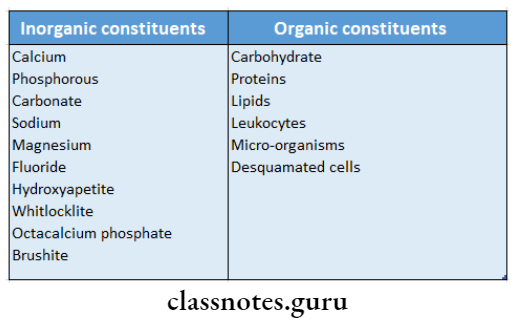
2. Theories Of Calculus Formation
- Booster mechanism
- Colloidal proteins in saliva
- Liberation of phosphate
- Epideictic concept
- Inhibition theory
Read And Learn More: Periodontics Question and Answers
3. Differences Between Supra gingival And Subgingival Calculus

4. Modes Of Attachment Of Calculus
- By means of an organic pellicle
- By mechanical interlocking into lacunae and caries
- Penetration into cementum
- Close adaptation to cementum surface
5. Sequele Of Food Impaction
- Gingivitis
- Periodontal pocket
- Bone loss
- Tooth mobility
6. Factors Causing Vertical Food Impaction
- Uneven occlusal wear
- Opening of the contact point
- improper restoration
7. Stains And Their Causes
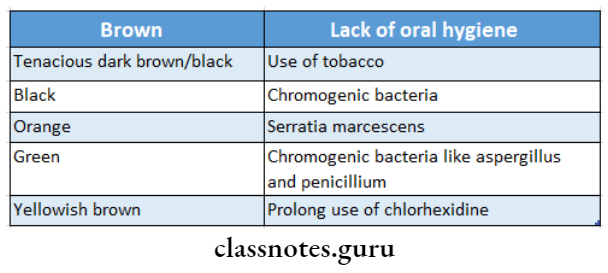
8. Features of Different Terms
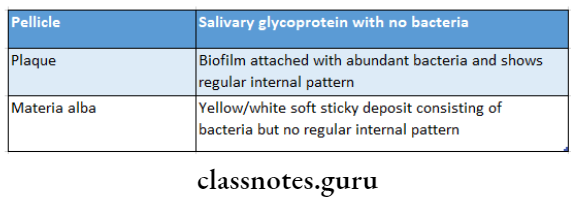
Dental Calculus And Other Etiological Factors Long Essays
Question 1. Define and classify calculus. Describe its structure, composition, and etiology.
Answer:
Calculus Definition:
- Calculus is an adherent, calcified, or calcifying mass that forms on the surfaces of teeth and dental appliances
Calculus Types:
1. Supra gingival:
- Location – Above gingival margin
- Formation – From salivary secretion
2. Subgingival:
- Location – Below free gingiva
- Formation – Gingival exudates
Calculus Structure
- Supra gingival: Whitish yellow in color
- Subgingival: Dark brown or greenish black
Calculus Forms:
- Ring like
- Ledge like
- Crusty
- Spiny
- Nodular
- Finger-like
- Fern-like
Calculus Composition:
Calculus Inorganic constituents:
- Calcium
- Phosphorous
- Carbonate
- Sodium
- Magnesium
- Fluoride
- Hydroxyapatite
- Whitlock lite
- octacalcium phosphate
- Brush it
Calculus Organic constituents:
- Carbohydrate
- Proteins
- Lipids
- Leukocytes
- Micro-organisms
- Desquamated cells
Calculus Etiology:
- Bacterial deposits
- Poor oral hygiene
- Iatrogenic factors
- Faulty restoration
- Overhanging
- Plunger cusps
- Orthodontic appliances
- Unreplaced missing teeth
- Malocclusion
- Habits
Question 2. Discuss the role of iatrogenic factors in the etiology of periodontal diseases.
Answer:


Dental Calculus And Other Etiological Factors Short Essays
Question 1. Theories regarding mineralization of Dental calculus. (or) Theories of Calculus Formation.
Answer:
Precipitation of minerals due to a local rise in Calcium and Phosphate
1. Booster mechanism:
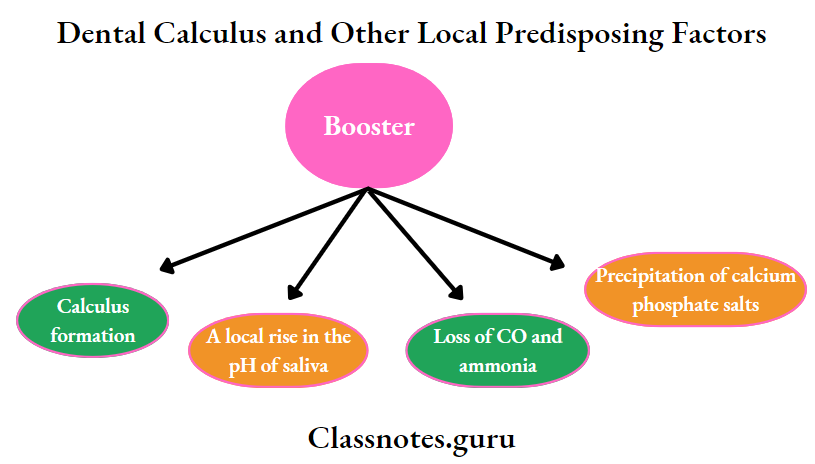
2. Colloidal proteins in saliva:
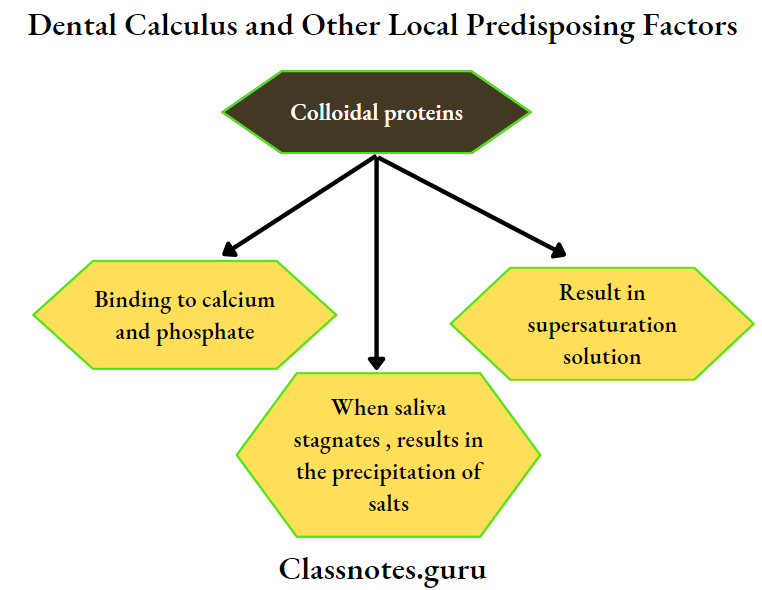
3. Liberation of phosphatize:
- By precipitation of calcium phosphate
4. Epideictic concept:
- Seeding agents (intercellular matrix of plaque, carbohydrate, protein complexes, and plaque bacteria)
- Induce small foci of calcification
- These enlarge and form calcification
5. Inhibition theory:
- States that calcification occurs at specific sites because of inhibiting mechanism at non-calcifying sites
- At the calcifying site, the inhibiting mechanism is removed
Example: Pyrophosphate
Question 2. Supra and Subgingival Calculus/Difference between supra gingival and subgingival Calculus. Answer:
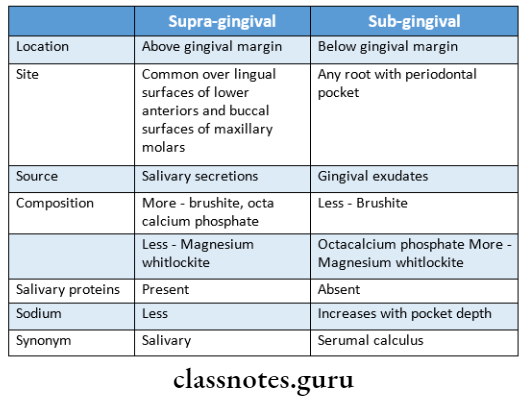
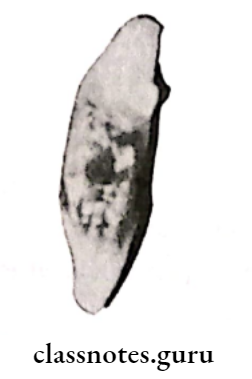
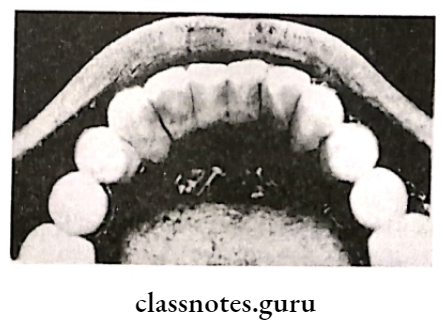
Question 3. Modes of attachment of calculus.
Answer:
- By means of an organic pellicle
- By mechanical interlocking into lacunae and caries
- Penetration into cementum
- Close adaptation to cementum surface
Dental Calculus And Other Etiological Factors Short Answers
Question 1. Pathologic migration of tooth/ Causes of Patho- Faulty restoration logic migration.
Answer:
Refers to tooth displacement that results when the balance among the factors that maintain physiologic tooth position is disturbed by periodontal disease. Teeth affected: Common in the anterior region
Pathologic Migration of Tooth Symptoms:
- Mobility of teeth
- Rotation of teeth
- Extrusion
Pathologic Migration of Tooth Causes:
- Weakened periodontal support
- Changes in forces exerted on teeth
- Unreplaced missing teeth
- Failure to replace the first molar
Pathologic Migration of Tooth Other Causes:
- Pressure from tongue
- Pressure from granulation tissue
Question 2. Epideictic concept of calculus formation.
Answer:
- Seeding agents (intercellular matrix of plaque, carbohydrate, protein complexes, and plaque bacteria)
- Induce small foci of calcification
- These enlarge and form calcification
Question 3. Modes of Attachment of Calculus.
Answer:
- By means of an organic pellicle
- By mechanical interlocking into lacunae and caries
- Penetration into cementum
- Close adaptation to cementum surface
Question 4. Etiological Significance of Calculus.
Answer:
- Initially, calculus causes damage to the gingival margin
- Provides retention of more microorganisms
- Brings microorganisms close to supporting structures
- Interferes with a self-cleansing mechanism
- Initiates periodontal destruction
- Results in periodontal diseases
Question 5. Bruxism.
Answer:
Bruxism is the unconscious grinding of teeth, usually at nighttime.
Bruxism Types:
- Nocturnal
- Diurnal
Bruxism Features:
- Presence of Occlusive factors
- No association with periodontal disease
- Lead to tooth fracture
- Tooth wear
- Muscle hypertrophy
Bruxism Etiology:
- Occlusive disharmony
- Psychological
Bruxism Treatment:
- Maxillary stabilization
Question 6. The sequence of food impaction.
Answer:
- Gingivitis
- Periodontal pocket
- Bone loss
- Tooth mobility
Question 7. Etiological significance of calculus in periodontitis (or) What is the role of calculus in periodontitis?
Answer:
Role Of Calculus In Periodontitis:
- Calculus provides a fixed nidus for continuous plaque accumulation
- It brings plaque bacteria close to the supporting tissues • Interferes with a local self-cleansing defense mechanism
- Acts as a reservoir for irritating substances such as en- endotoxins, antigenic material, and bone-resorbing factors
- Makes plaque removal more difficult for the patient
Question 8. Define Food Impaction.
Answer:
Forceful wedging of the food into the periodontics by occlusive forces
Food Impaction Causes:
- Uneven occlusal wear
- Loss of proximal contact
- Congenital abnormalities
- Faulty restoration
Dental Calculus And Other Etiological Factors Viva Voce
- Anti-tartar agents are triclosan, pyrophosphate, and zinc salts
- Anti-tartar agents inhibit mineralization
- Calculus embedded deeply into the cementum is called calculocementum
- Calculus provides a fixed nidus for the continued accumulation of plaque
- The irritating effect of material alba on the gingival is caused by bacteria and their products
- Distolingual cusp of upper second molar is common- est plunger cusp
- Subgingival calculus is dark green or dark brown because of the presence of blood products
- A. viscous possess fimbriae that help bond to the dental pellicle
- The location and extent of the subgingival calculus may be evaluated clinically by the explorer
- Calculus attaches to the tooth surface through chemical bonding to the hydroxyapatite
- In the pathogenesis of periodontal disease, calculus acts as a contributing factor.
